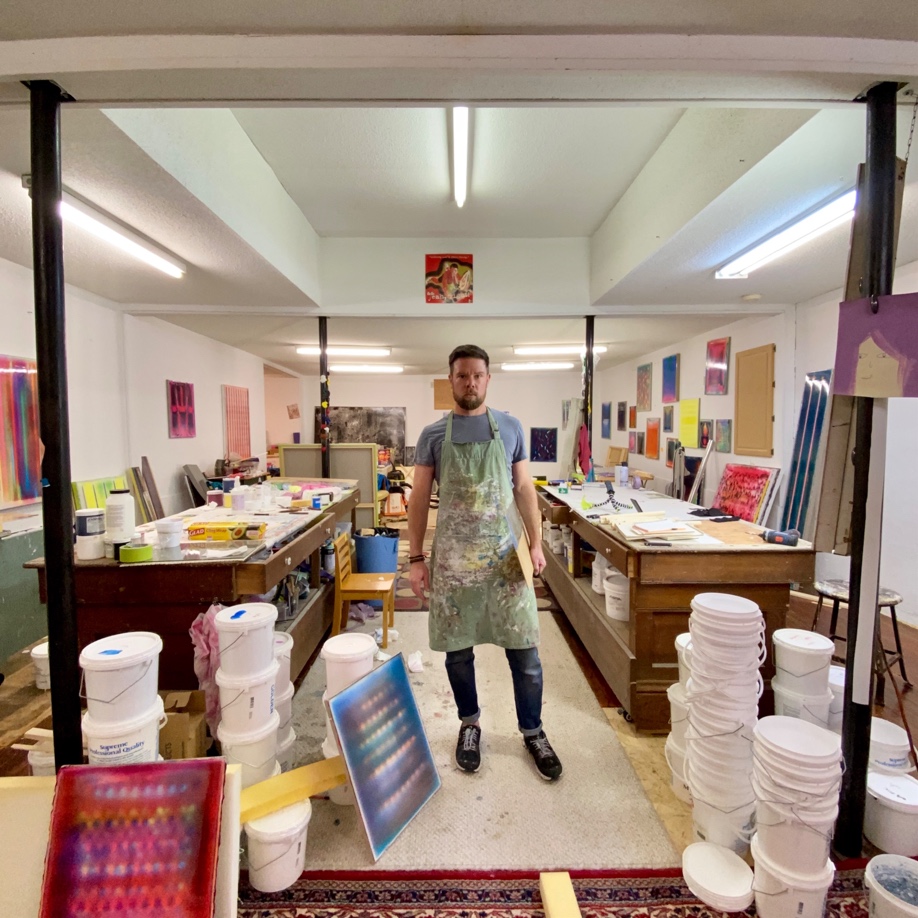
RC: Perhaps one of the most literal exhibition titles I’ve chosen, “Myriad” (noun: an extremely great number / in classical history, a unit of ten thousand / adjective: innumerable) makes reference to the vast amount of color combinations and styles that I am able to achieve through my painting process, often using only the primary colors (Red, Yellow and Blue).
RA: How long have you defined yourself as an artist?
RC: Defining myself as an artist is something that existed peripherally. It wasn’t until I devoted my time fully to making art that I felt like I deserved to refer to myself as an artist, as if it were an honour to be bestowed and I hadn’t yet earned it. There were several years where I worked a corporate job and made paintings on the side which felt backwards. Painting was more than a hobby for me, so I quit and went back to school over a decade ago. Embracing my identity as an artist was empowering.
RA Tell us more about your use of colour and shape.
RC: I remember a series of paintings that I made in grad school where I used only grayscale. The idea was to remove color to both focus on other formal decisions like composition and to examine how I would go about reintroducing color back into the work. It flooded back in. I’ve always used a fairly saturated palette and that didn’t change. Because I paint with layers of translucent color, I spend a significant amount of time deciding on color combinations and how they will interact. These decisions are largely instinctual and I learn from trial and error. From the intensity of the tint, to the the thickness of an applied layer of paint, to combining with the layers below, there are endless variables to account for with color. I am always surprised by the myriad of results that can be achieved by mixing only the primary colors.
I can recall deciding to remove intentional shapes of my creation from my compositions. The idea was to allow the painting process and the object being painted to reveal shape as a record of its creation and to expose the underlying structure instead of hiding or ignoring it. The relationship between shape and gesture blurred. Imperfect pattern, repetition and symmetry have always been recurring themes in my work and a regular rectangular canvas is the perfect set up to investigate them. For the most part, my paint strokes cover the entire surface from top to bottom. This naturally results in an imperfect symmetrical balance and my default composition. Aberrations in the painted surface and contact with the structure behind the canvas organically create shapes that reference frottage and human versus machine production. The challenge of deciding which naturally occurring, process-caused shapes should be edited out by another pass of paint or left in as a relic of its creation is endlessly gratifying.
RA: Where does your inspiration come from?
RC: It’s an amalgamation, the ingredients for the stew of my subconscious. It’s the imagined alien sunset, the vibrant animated images of video games, the glow of neon beer signs through a smoky haze in our local dive bar in my 20’s, the bioluminescence of deep sea creatures, Dan Flavin and James Turrell’s perplexing use of light and color, deep space imagery from exploratory probes, dappled morning sunlight spilling through a window ever-changing and alive, lightsabers and lasers, kaleidoscopes and the county fair...it’s all of those things and none of them specifically. It’s chasing the sublime in the hopes of seeing something new and different that radiates with an inexplicable energy.
RA: If you were standing beside someone as they were looking at one of your pieces - what details would you bring to their attention?
RC: I prefer to listen to someone’s thoughts and opinions or answer questions...but if I had to draw their attention to something, it would be the excess paint that almost floats in space at the edges of my paintings, acting as a natural frame for the canvas and historical recording of the process. The most difficult part of the creative process is maintaining an openness to inspiration. I have a tendency to overthink things, so when inspiration strikes, I try not to obstruct or control it too much. And when life gets in the way and I’m struggling, I think of Sol LeWitt’s letter to Eva Hesse and just “Do”.

